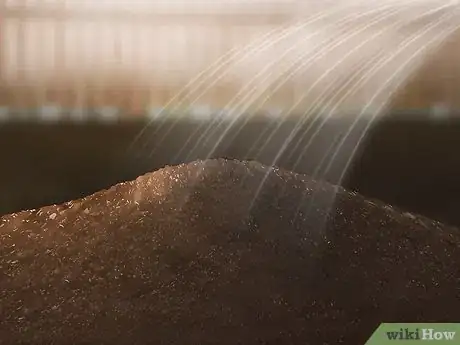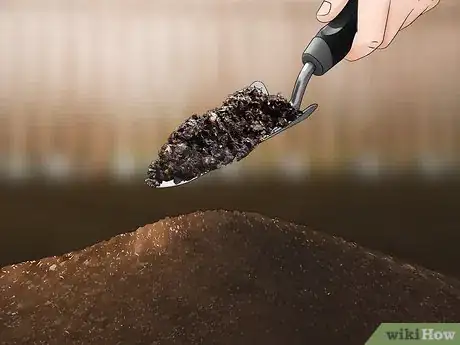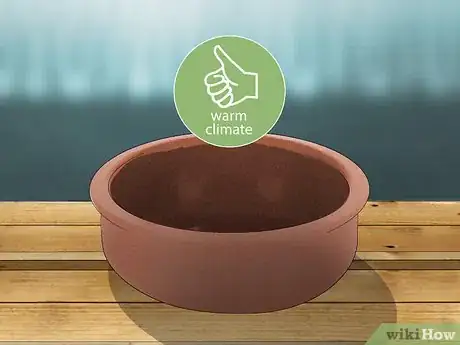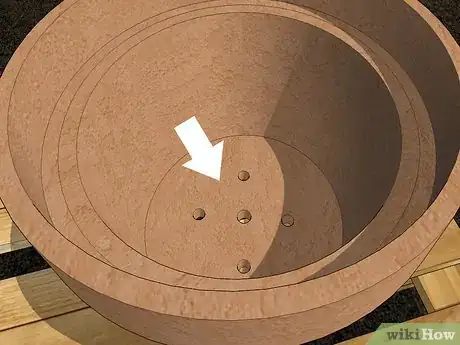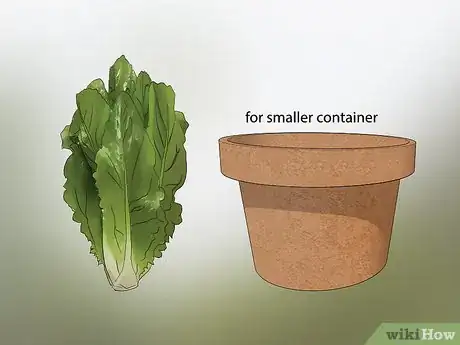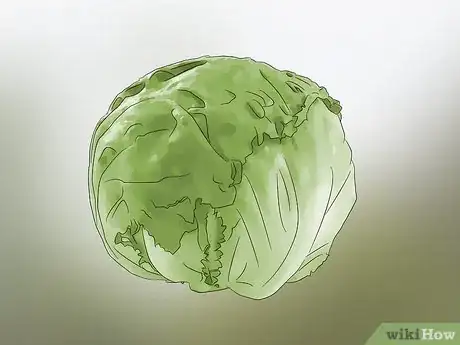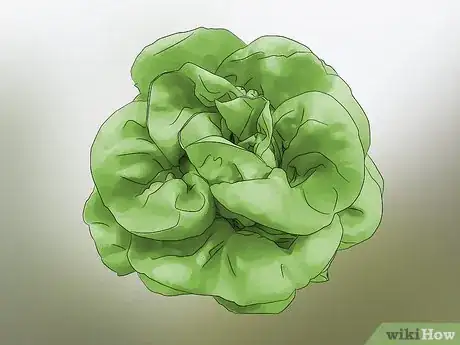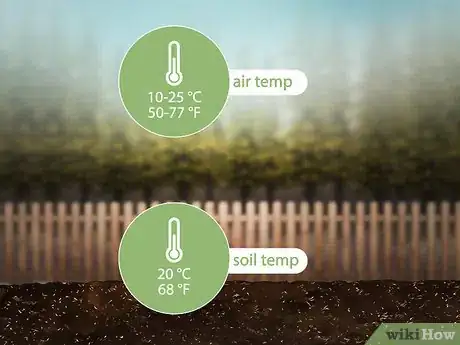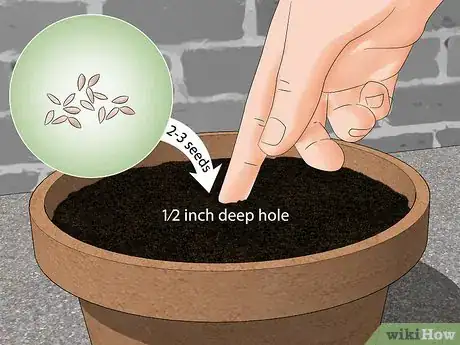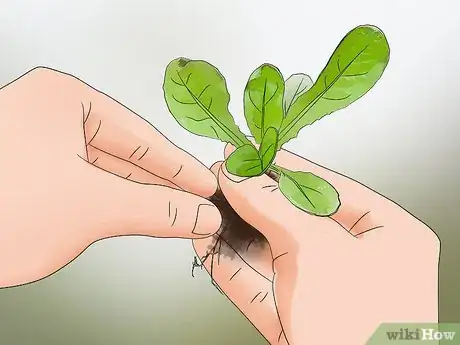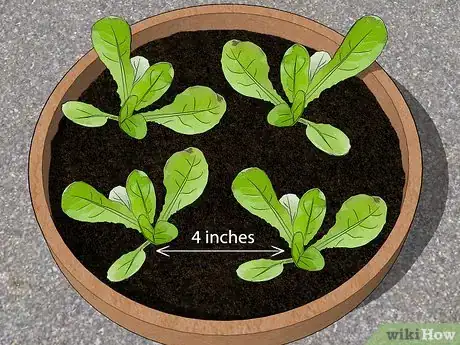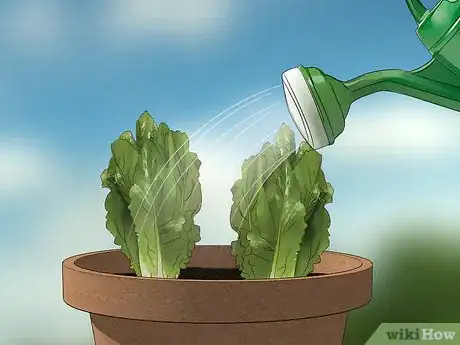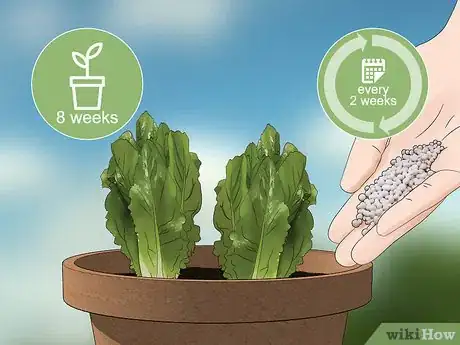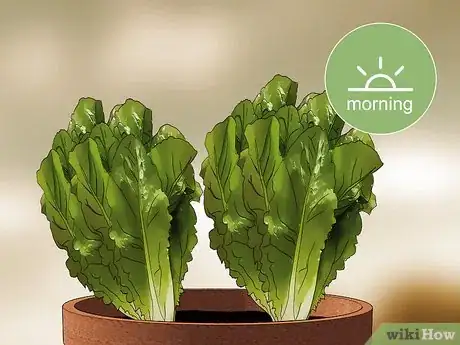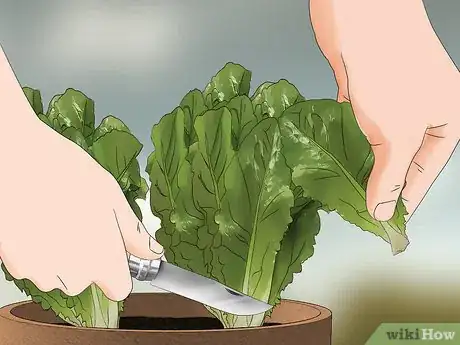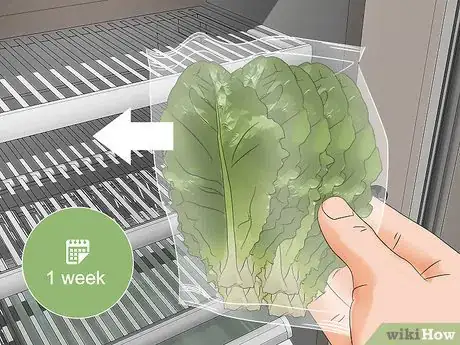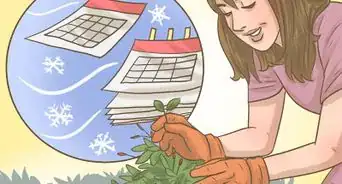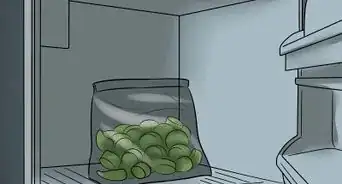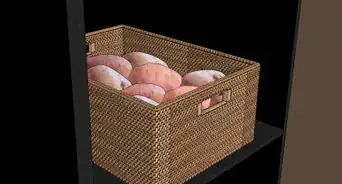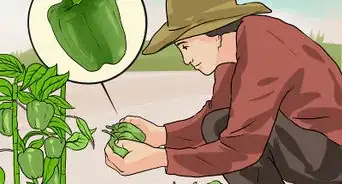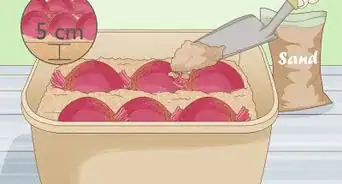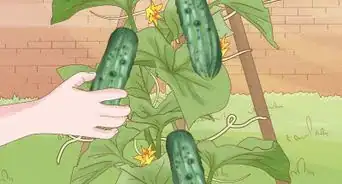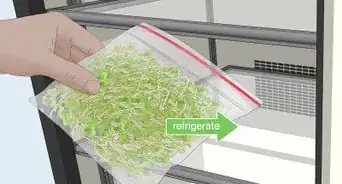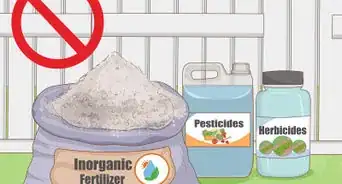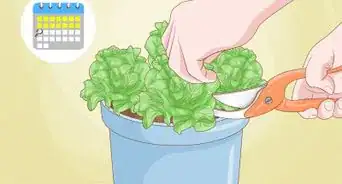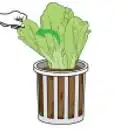This article was co-authored by wikiHow Staff. Our trained team of editors and researchers validate articles for accuracy and comprehensiveness. wikiHow's Content Management Team carefully monitors the work from our editorial staff to ensure that each article is backed by trusted research and meets our high quality standards.
There are 30 references cited in this article, which can be found at the bottom of the page.
This article has been viewed 30,580 times.
Learn more...
If you’re looking to start grow lettuce at home, but don’t have a ton of space to do so, growing lettuce in a pot is a great option. Lettuce is very nutrient-dense, grows quickly, can be grown close together in a pot, and is hard to kill! Select the right soil type, prepare your pot, choose your lettuce variety, and take good care of your lettuce to have delicious greens for your salads right when you want them!
Steps
Choosing and Preparing the Soil
-
1Choose a potting-specific soil or mix your own. Specialized potting soil tends to be looser and better at retaining water than regular garden soil. It also won’t clump together as much.[1] Regular garden soil will often pack together tightly and deprive the roots of the oxygen that they need.
- It’s also easy to make your own potting soil at home! Mix 1 part perlite (white volcanic glass that is used to lighten soils), 1 part vermiculite (mineral that is used in potting soils to increase water retention), and 1 part compost to create a very loose mixture that is pretty close to what you can buy in the store.[2]
-
2Pre-moisten your soil by wetting it with a hose. Use a hose or watering can to give the soil some moisture. Wet it enough so that it is damp, but not so generously that it is soaked. Pre-moistening the soil can help lettuce transplants adjust to the pot and can also make seeds germinate faster.[3]Advertisement
-
3Add organic matter to the soil to increase the nitrogen level. Lettuce needs nitrogen in its soil to do well, and this can be done by mixing lots of organic matter. Some great options are compost, rotting manure, or leaf mold.[4]
- Soil blends that are 20-50% organic matter work best for potted plants, as they stop the soil from drying out quickly. To make a soil mixture that is 20% organic matter, mix 4 containers of soil with 1 container of organic matter, like compost.[5]
Preparing Your Pot
-
1Choose a pot that’s at least 14 in (36 cm) wide and 6 in (15 cm) deep. Pots that are shallow and on the wider side tend to work best. Lettuce doesn’t have a very deep root system, and the plants themselves generally don’t grow taller than 1 ft (0.30 m) in height.[6]
- When deciding on a pot size, think about what type and how much lettuce you want to grow. Loose-leaf lettuces can be planted as close as 4 in (10 cm) apart, but larger head lettuces should be spaced around 6 in (15 cm) apart.
-
2Opt for a clay pot if you live in a warm climate. Generally, any material, from plastic to ceramic to terracotta, will work for growing your plants. However, if you live in a particularly warm climate where the temperature regularly rises above 77 °F (25 °C), opt for a clay pot or other type of heat-tolerant container to give your lettuce the best possible shot at survival.[7]
- Also, keep the color of the pot in mind. Light-colored pots reflect sunlight and tend to absorb less heat than dark-colored pots.[8]
-
3Make sure the bottom of the pot has plenty of drainage holes. This allows any excess water to drain out of the pot. If the container that you’re using is plastic, use an electric drill or a hammer and nail to make holes in the underside of the pot.[9]
- If you’re planning to keep your pot indoors, be sure to place a saucer or other kind of water collection dish underneath your pot to stop any draining water from seeping out onto your floor.
-
4Fill the pot until the soil line is about 2 in (5.1 cm) from the pot’s rim. Avoid filling the pot all the way to the top, because this can make it easier to damage the crowns of the lettuce when you harvest them. Gently press the soil down into the pot so it compacts.[10]
Picking a Lettuce Variety
-
1Choose Romaine lettuce if you have a smaller container. Romaine is a great lettuce for smaller pots because it needs less room to grow. It grows outward from a tight center, and can survive in mild heat. Romaine typically takes about 75-80 days to mature.[11]
- There are different varieties of Romaine lettuce to choose from, but Parris Island, or Cos, is the most popular.
- Romaine lettuce also tends to do pretty well indoors.[12]
-
2Plant iceberg lettuce if you have a lot of time to let your lettuce grow. Iceberg lettuce is the most recognizable form of crisphead lettuce. It has less nutrients than other varieties, a high water content, and a pretty flat taste. It takes a little longer to grow — about 80 to 95 days, and generally needs more space to mature into large heads.[13]
- Iceberg lettuce is very much a cool-weather crop, so plant it as early in the spring as possible.[14]
-
3Opt for loose-leaf lettuce if you live in a warmer climate. Loose-leaf lettuces, such as Oakleaf and Deer Tongue, are the most successful in hot climates. Note that they do tend to have a stronger taste than other varieties. They take about 70 to 85 days to grow.
- Loose-leaf lettuce has the most variation in color and taste, so do some research on which types of loose-leaf you want to try.[15]
-
4Grow butterhead lettuce if you want a sweeter taste. Butterhead lettuce is known for its sweet, “buttery” taste and velvety leaf texture. It takes around 45 to 55 days to grow, but can really be harvested at any point in its development.[16]
- Butterhead is also much higher in nutrition than other lettuce varieties.[17]
Planting Your Lettuce
-
1Plant lettuce when the weather is cooler. Lettuce grows best in air temperatures ranging from 50 to 77 °F (10 to 25 °C), with the ideal soil temperature being 68 °F (20 °C).[18] The best times to plant lettuce tend to be early spring and early fall, when the weather is more temperate.[19]
- Lettuce that sprouts in hot conditions usually produces a plant hormone that stops the germination of lettuce, leading the plants to quickly die out.
- If you are planning on planting your lettuce during the warmer parts of the year, soak the seeds or the root systems of your seedlings in cool water for at least 16 hours to increase the likelihood of germination.
-
2Sow lettuce seeds directly into your pot. Use your finger to poke holes in the soil that are about 1⁄2 in (1.3 cm) deep. Then, place 2-3 seeds in each hole. Once you’ve filled all the holes, sprinkle another layer of potting soil — about 1⁄4 in (0.64 cm) thick — over the top of the holes.[20]
- Putting 2-3 seeds in each hole may seem like a lot, but keep in mind that not all of the seeds will germinate.
-
3Plant lettuce seedling transplants by loosening the roots. Nurseries often sell lettuce seedlings in individual plastic cells that you can transfer to your prepared pot. Simply press on the sides of the cell to loosen the seedling’s roots and gently pull it out. Then, gently pull the bottom parts of the root apart to loosen it. Finally, bury the plant’s root system in the soil and gently pad the soil in around the base of the plant.[21]
- Soaking your lettuce transplants in cold water overnight before potting them can increase the chances of their survival.
-
4Space the lettuce plants 4 to 6 in (10 to 15 cm) apart. Leaving 4 to 6 in (10 to 15 cm) between each plant gives the lettuce enough room to develop into beautiful heads. However, spacing doesn’t have to be exact with lettuce, because you will be harvesting the plants fairly often.[22]
Caring for Your Lettuce
-
1Give your lettuce at least 4 hours of direct sun exposure. Avoid leaving your lettuce in the sun for longer than 7 hours. Strong, hot sun exposure — particularly in the warmer afternoons — can be damaging to lettuce, so move your lettuce to shade in the afternoon.[23]
- The ability to simply move your lettuce pot to control sun exposure is one of the great benefits of container gardening.
-
2Water your lettuce so the soil stays moist. Lettuce is made up of about 95% water, so it needs a lot of water to stay crisp and firm. Try to keep the soil slightly moist at all times, which can mean watering deeply 1-2 times a week during periods without regular rainfall.[24] Keeping your lettuce well-watered can often help to keep aphids at bay.[25]
- Avoid soaking the lettuce and over-watering it. This can result in root rot, stunted growth, and disease.[26]
- Try to water your lettuce in the early morning or late afternoon. This prevents the mid-day sun from evaporating the water before it really soaks into the soil.
-
3Fertilize every 2 weeks once your lettuce is 8 weeks old. If you want to give your lettuce a growth boost once it is at least 8 weeks old, apply liquid or granular balanced fertilizer to the plants. This can be helpful if you have planted a lot of lettuce very close together, because those plants are going to require a lot of nutrients.[27]
- When choosing a fertilizer, look for one that is well-balanced with equal parts nitrogen, phosphate, and potassium. These are sometimes marked as 10-10-10 or 5-5-5 mixtures.[28]
Harvesting Your Lettuce
-
1Harvest your lettuce in the morning. Lettuce is at its most crisp in the early morning. This is because exposure to sunlight can wilt and damage the tender leaves.[29]
-
2Cut away the outer leaves, leaving the plant’s base to re-grow. When the lettuce leaves are 4 to 6 in (10 to 15 cm) tall, use scissors or a knife to slice away the outermost, most mature leaves from the base of the plant, which is typically called the crown. Leave the small, immature leaves at the heart of the plant to continue growing, and return to re-harvest later in the week.[30]
- This method is often called the cut-and-come-again method.
- You can harvest lettuce by pulling the whole head out, but using this method will shorten the life and decrease the production of your plant.
- Avoid damaging the crown of the plant while you harvest. This can kill the plant.
- For romaine lettuce, see How to Harvest Romaine Lettuce.
-
3Store lettuce in your fridge for up to a week. To maximize freshness, soak your lettuce leaves in an ice bath for 5 minutes immediately after harvesting.[31] Then, keep your lettuce wrapped in a damp paper towel or in a plastic bag in the fridge to keep it fresh for as long as possible.
Warnings
- When harvesting lettuce, remember to take only the amount that you need. This will allow immature leaves to grow as big as possible.[33]⧼thumbs_response⧽
- If the weather gets too warm, your lettuce might begin to bolt — meaning that it will sprout a seed stalk and its leaves will turn bitter. When this happens, remove the plant entirely.[34]⧼thumbs_response⧽
- If the tips of your lettuce leaves start to turn brown, try giving them more water. If they are getting enough water, try cutting back on the amount of fertilizer you use.[35]⧼thumbs_response⧽
Things You’ll Need
- Potting-specific soil mix
- Water
- Organic matter (compost, rotting manure, leaf mold)
- Pot (at least 14 in (36 cm) wide and 6 in (15 cm) deep)
- Saucer (to collect draining water)
- Lettuce seeds or seedlings
- Fertilizer
- Scissors
References
- ↑ https://www.youtube.com/watch?v=mZJD4lu9vOY&feature=youtu.be&t=3m30s
- ↑ https://www.youtube.com/watch?v=mZJD4lu9vOY&feature=youtu.be&t=4m30s
- ↑ https://www.youtube.com/watch?v=mZJD4lu9vOY&feature=youtu.be&t=6m36s
- ↑ https://www.burpee.com/gardenadvicecenter/vegetables/lettuce/all-about-lettuce/article10236.html
- ↑ https://www.pca.state.mn.us/sites/default/files/h-hhw1-36.pdf
- ↑ https://www.youtube.com/watch?v=K4nlJ2u248k&feature=youtu.be&t=17s
- ↑ https://www.youtube.com/watch?v=ZUE6qFgYtXo&feature=youtu.be&t=1m21s
- ↑ https://www.grow-it-organically.com/container-garden-temperature.html
- ↑ https://www.youtube.com/watch?v=K4nlJ2u248k&feature=youtu.be&t=30s
- ↑ https://www.youtube.com/watch?v=mZJD4lu9vOY&feature=youtu.be&t=4m51s
- ↑ https://countrysidenetwork.com/daily/growing/growing-systems-tools-gardening/guide-growing-lettuce-in-containers/
- ↑ http://gardenersnet.com/vegetable/romaine.htm
- ↑ https://countrysidenetwork.com/daily/growing/growing-systems-tools-gardening/guide-growing-lettuce-in-containers/
- ↑ http://www.gardenersnet.com/vegetable/iceberg.htm
- ↑ https://www.lsu.edu/agriculture/plant/extension/hcpl-publications/lettuce-pub3363.pdf
- ↑ http://www.heirloom-organics.com/guide/va/1/guidetogrowingbutterheadlettuce.html
- ↑ https://www.goodhousekeeping.com/home/gardening/a20707140/growing-lettuce/
- ↑ https://www.motherearthnews.com/organic-gardening/better-lettuce-seed-germination-zbcz1402
- ↑ https://bonnieplants.com/growing/growing-lettuce/
- ↑ https://www.youtube.com/watch?v=f0JNK8de6xo&feature=youtu.be&t=25s
- ↑ https://www.youtube.com/watch?v=upIGYuzHqmU&feature=youtu.be&t=2m11s
- ↑ https://www.youtube.com/watch?v=K4nlJ2u248k&feature=youtu.be&t=1m37s
- ↑ https://www.youtube.com/watch?v=mZJD4lu9vOY&feature=youtu.be&t=8m47s
- ↑ https://www.youtube.com/watch?v=K4nlJ2u248k&feature=youtu.be&t=2m10s
- ↑ https://www.rhs.org.uk/advice/grow-your-own/vegetables/lettuce
- ↑ https://gilmour.com/growing-lettuce
- ↑ https://www.youtube.com/watch?v=mZJD4lu9vOY&feature=youtu.be&t=9m42s
- ↑ https://www.backyard-vegetable-gardening.com/watering-lettuce.html
- ↑ https://countrysidenetwork.com/daily/growing/growing-systems-tools-gardening/guide-growing-lettuce-in-containers/
- ↑ https://www.youtube.com/watch?v=EkvNU6dG0pA
- ↑ https://www.southernliving.com/home-garden/gardens/lettuce-feast
- ↑ https://bonnieplants.com/growing/growing-lettuce/
- ↑ https://www.gardeners.com/how-to/growing-lettuce-indoors/8573.html
- ↑ https://bonnieplants.com/growing/growing-lettuce/
- ↑ https://bonnieplants.com/growing/growing-lettuce/

